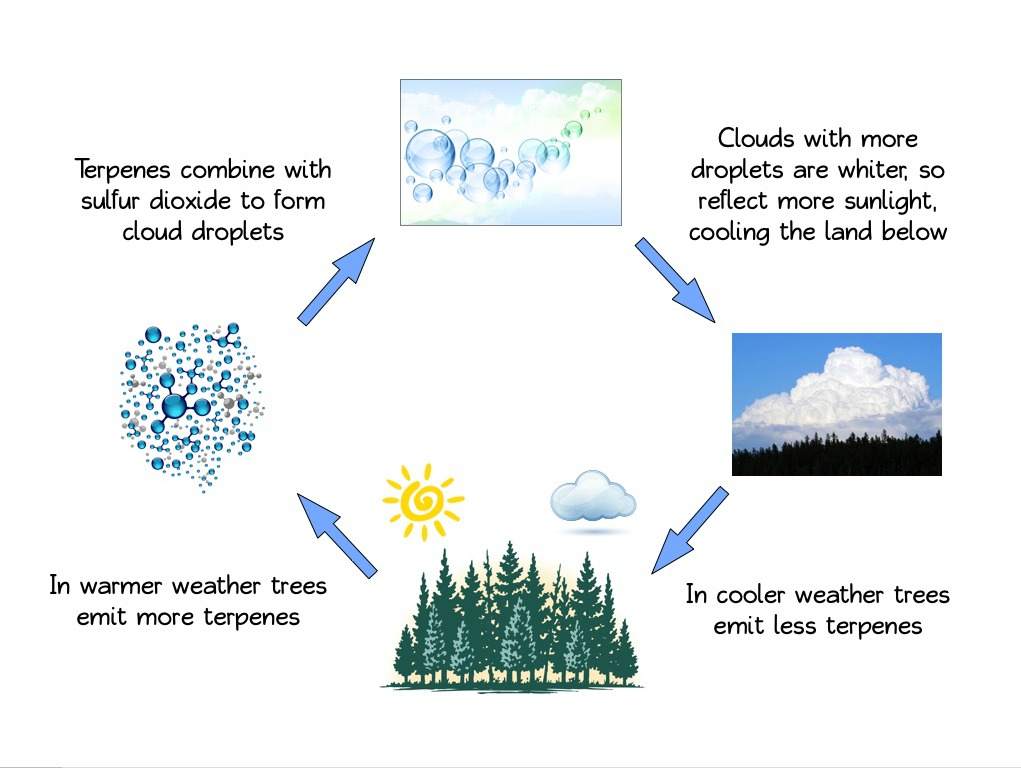“It now appears that the world would have warmed more than it has were it not for the aromatic cocktail of chemicals emitted by plants. It turns out that this can change the weather – and anything that changes the weather day after day and year after year changes the climate too. While this mechanism is nowhere near strong enough to save us from global warming, it may have been stronger in the past when the air was cleaner. So could it be that Gaia is not powerless after all?” ~ Stephen Battersby
It has long been suspected that the envelope of essential oil vapor around an aromatic plant helps protect it from extremes of temperature, especially heat. It makes sense that higher temps lead to greater essential oil evaporation, and this in turn has a cooling effect on the plant, since evaporation from a surface is always cooling. Until recently, no one imagined that there might be a cooling phenomenon taking place on a much larger scale.
There is always moisture in the ambient air, and there are also tiny particles such as salt and dust – these are called aerosols. The water vapor and aerosols are constantly bumping into each other. When the air is cooled, some of the water vapor sticks to the aerosols when they collide – this is known as condensation. Eventually, bigger water droplets form around the aerosol particles, and these clump together with other droplets, forming clouds.
The Gaia hypothesis
The Gaia hypothesis is James Lovelock’s idea that the planet is capable of environmental self-regulation (Lovelock & Margulis 1974). In 1987, Lovelock and others proposed a feedback mechanism involving the oceans that could counterbalance global warming. Called the CLAW (after its authors) hypothesis, this proposed that algae in the sea emit a gas called dimethyl sulfoxide, which can react with air to form sulfuric acid vapor and condense into aerosols (Charleson et al 1987).
Warmer weather causes greater algal growth, and the aerosols could feasibly cool the planet by reflecting sun directly, and also indirectly by making clouds whiter. However, water droplets do not form and grow unless they are at least 100 nanometers in size, and models of the CLAW hypothesis later showed that the formed particles would not reach even close to this size. In addition, not enough dimethyl sulfoxide is released to make a difference.
Boreal forest studies
In 2004, scientists at the University of Helsinki proposed an alternative model involving pine trees instead of algae (Kulmala et al 2004). They hypothesized that increased temperatures and atmospheric CO2 would lead to increased photosynthesis and forest growth, leading to an increase in pine oil emissions. Pine oil is mostly composed of monoterpenes such as limonene and pinene. These terpenes rise above the trees and combine with sulfur dioxide and other aerosols to form especially large cloud-forming droplets.
Clouds with larger droplets are whiter, reflecting more sunlight back into space, cooling the land below, and thus counteracting the effects of global warming. More trees also mean more shade and more CO2 absorption, so there is a triple benefit. In warmer weather, trees emit significantly more terpenes, so there is a feedback effect (Fuentes et al 2000). It should also be noted that trees give off substantial amounts of isoprene, a very small molecule that also contributes to the effect. It is not a terpene, but monoterpenes consist of two isoprene units.
Global warming offset
This hypothesis now looks like a reality – warmer temperatures do result in greater emissions from, trees, which do cause whiter and larger clouds. A research team at Manchester University has demonstrated that, as aerosols and water accumulate, the presence of terpenes changes the chemistry of the drops, allowing them to attract more water, and this can substantially increase the number of droplets (Topping et al 2013). A cloud with a greater concentration of droplets is a whiter, fluffier cloud.
The clincher comes from a study involving 11 weather stations around the planet. A team including Markku Kulmala and Paul Paasonen, also at Helsinki, sampled the air at these stations, counting the number of aerosols of 100 nanometers or larger (AE100), and the level of terpenes (Paasonen et al 2013). They found a clear pattern – the effect is strongest in places such as eastern Siberia and Finland, where the air is clean. “But in more polluted areas, the feedback is not significant” says Paasonen.
The extent of the effect is not known, but it may not be very big. It could offset global warming by as much as 10%, or it might be less than 1%. In a study of subtropical forest in Taiwan, 42% of terpene emissions contributed to AE100 formation, but the ‘total ozone formation potential’ (OFP) from terpene emissions was only 5.6% of the total OFP (Salvador et al 2020).
Contributors to the effect
In theory, the feedback loop will also apply to any large plantation of aromatic plants, but forests may be the only significant contributor because of their mass. The type of forest, and associated ambient temperature, determines the extent of cloud seeding. Boreal forest (Canada, Russia) contributes relatively little, temperate forest (Europe, Australia) contributes more, and tropical forest (notably Brazil) contributes the most (Bourtsoukidis et al 2024). The authors determined that there is a linear relationship between higher ambient temperature and terpene emissions.
A Finnish study found significant terpene emissions from wetlands, again depending on temperature, and they reported that aerosol formation was more efficient than from a typical boreal forest. Wetlands also emit significant amounts of methane, which contributes to atmospheric warming, but the authors suggest that wetlands deserve more study in order to understand climate change (Junninen et al 2022).
Sesquiterpenes have not been much studied because of their lower volatility. However, in a lab study, it was found that a mixture of 1 part β-caryophyllene (a sesquiterpene) along with 6 parts α-pinene and 50 parts isoprene doubled the particle formation rate compared to without the β-caryophyllene (Dada et al 2023). This, and other lab work is being carried out in order to predict changes in a warming planet, and to possibly find solutions to our climate crisis.
Footnote
The terpenes are only able to contribute to cloud formation because, once in the atmosphere, they are oxidized by ozone and other gases into slightly larger particles, and this is an important step in the process. So more ozone could also lead to whiter, larger clouds, again supporting the Gaia hypothesis. This is somewhat ironic because high ozone at ground level also oxidizes these terpenes, and inhaling the resulting oxidation products can cause respiratory problems. So what is good for the planet above tree level is not so good for people with respiratory problems below. Fortunately, this only happens where there are high ozone levels.
References
Battersby S 2013 Call in the Clouds. New Scientist issue 2923: 32-35 http://www.newscientist.com/article/mg21829231.900
Bourtsoukidis, E., Pozzer, A., Williams, J. et al 2024. High temperature sensitivity of monoterpene emissions from global vegetation. Communications Earth and Environment, 5(1), 1–10. https://doi.org/10.1038/s43247-023-01175-9
Charlson RJ, Lovelock JE, Andreae MO, Warren G 1987 Oceanic phytoplankton, atmospheric sulphur, cloud albedo and climate. Nature 326 (6114): 655–661 doi:10.1038/326655a0
Dada, L., Stolzenburg, D., Simon, M. et al 2023. Role of sesquiterpenes in biogenic new particle formation. Science Advances, 9(36), 1–14. https://doi.org/10.1126/SCIADV.ADI5297
Fuentes JD, Lerdau M, Atkinson R et al 2000 Biogenic hydrocarbons in the atmospheric boundary layer: a review. Bulletin of the American Meteorological Society 81: 1537-1575 http://nature.berkeley.edu/biometlab/espm228/Fuentes%20et%20al%20BAMS%202000.pdf
Junninen, H., Ahonen, L., Bianchi, F. et al 2022. Terpene emissions from boreal wetlands can initiate stronger atmospheric new particle formation than boreal forests. Communications Earth and Environment, 3(1), 1–9. https://doi.org/10.1038/s43247-022-00406-9
Kulmala M, Suni T, Lehtinen KR et al 2004 A new feedback mechanism linking forests, aerosols, and climate. Atmospheric Chemistry & Physics 4: 557-562 http://hal.archives-ouvertes.fr/docs/00/29/54/16/PDF/acp-4-557-2004.pdf
Lovelock JE, Margulis, L 1974 Atmospheric homeostasis by and for the biosphere: the Gaia hypothesis. Tellus Series A 26: 2–10 http://www.gps.caltech.edu/classes/ge148c/pdf%20files/lovelock.pdf
Paasonen P, Asmi A, Petaja T et al 2013 Warming-induced increase in aerosol number concentration likely to moderate climate change. Nature Geoscience 6: 438-442 http://www.nature.com/ngeo/journal/v6/n6/full/ngeo1800.html
Salvador, C. M., Chou, C. C. K., Ho, T. T. et al 2020. Contribution of terpenes to ozone formation and secondary organic aerosols in a subtropical forest impacted by urban pollution. Atmosphere, 11(11), 1–13. https://doi.org/10.3390/atmos11111232
Topping D, Connolly P, McFiggans G 2013 Cloud droplet number enhanced by co-condensation of organic vapours. Nature Geoscience 6: 443-446 http://www.nature.com/ngeo/journal/v6/n6/full/ngeo1809.html





Dear Robert,
Gratitude to Stephen Battersby for the Gaia lens — showing so beautifully that nature holds within her the power to care for herself.
And gratitude to you for this inspiring piece, where science meets the living breath of the forest. It feels like a quiet return to the very source that began your aromatic journey — a place where the aroma can simply be, before the measuring begins.
Gaia, the master perfumer, blends the ten thousand perfumes into clouds that cool and shelter us — a fragrance both seen and unseen.
Coralie (student of the aroma lineage and masseuse) ⸰⋆𓋹⋆⸰